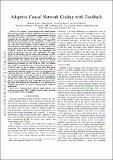Adaptive Causal Network Coding with Feedback
Author(s)
Cohen, Alejandro; Malak, Derya; Bracha, Vered Bar; Medard, Muriel
DownloadSubmitted version (2.811Mb)
Open Access Policy
Open Access Policy
Creative Commons Attribution-Noncommercial-Share Alike
Terms of use
Metadata
Show full item recordAbstract
© 1972-2012 IEEE. We propose a novel adaptive and causal random linear network coding (AC-RLNC) algorithm with forward error correction (FEC) for a point-to-point communication channel with delayed feedback. AC-RLNC is adaptive to the channel condition, that the algorithm estimates, and is causal, as coding depends on the particular erasure realizations, as reflected in the feedback acknowledgments. Specifically, the proposed model can learn the erasure pattern of the channel via feedback acknowledgments, and adaptively adjust its retransmission rates using a priori and posteriori algorithms. By those adjustments, AC-RLNC achieves the desired delay and throughput, and enables transmission with zero error probability. We upper bound the throughput and the mean and maximum in order delivery delay of AC-RLNC, and prove that for the point to point communication channel in the non-asymptotic regime the proposed code may achieve more than 90% of the channel capacity. To upper bound the throughput we utilize the minimum Bhattacharyya distance for the AC-RLNC code. We validate those results via simulations. We contrast the performance of AC-RLNC with the one of selective repeat (SR)-ARQ, which is causal but not adaptive, and is a posteriori. Via a study on experimentally obtained commercial traces, we demonstrate that a protocol based on AC-RLNC can, vis-à-vis SR-ARQ, double the throughput gains, and triple the gain in terms of mean in order delivery delay when the channel is bursty. Furthermore, the difference between the maximum and mean in order delivery delay is much smaller than that of SR-ARQ. Closing the delay gap along with boosting the throughput is very promising for enabling ultra-reliable low-latency communications (URLLC) applications.
Date issued
2020Department
Massachusetts Institute of Technology. Research Laboratory of ElectronicsJournal
IEEE Transactions on Communications
Publisher
Institute of Electrical and Electronics Engineers (IEEE)